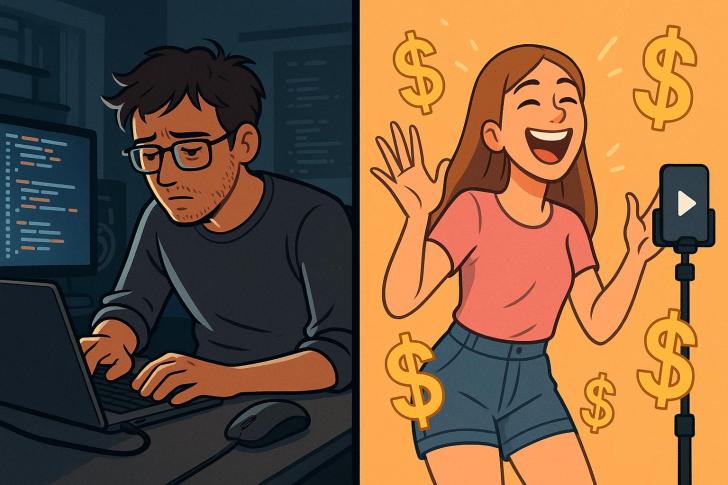Opinion / Columnist
The Irony of Innovation: How Tech’s Hardest Workers Built a System That Rewards Laziness
16 Jul 2025 at 20:49hrs |
0 Views

A thought-provoking look at how tech's unsung builders laid the groundwork for a digital culture that rewards viral ease over innovation and substance.
Decades ago, the architects of the internet weren't chasing followers - they were chasing possibility. In dim rooms lit by server LEDs and the glow of CRT monitors, engineers and developers laboured over tangled cables, debugging prototypes, driven by vision rather than vanity. No VC funding, no influencer deals - just the belief that with enough caffeine, collaboration, and code, they could build a digital future.
And they did.
From the ground up, they forged the infrastructure of today's online world: social platforms, search engines, cloud systems, databases - all crafted with precision and persistence. They dreamed of connection, open access, and global reach.
Yet somewhere along the way, the tech that demanded extraordinary effort began to reward effortless content.
Today, those same platforms are led by creators - many brilliant, hilarious, and inventive - but a surprising number thrive not through societal contribution, but through attention hijacking. Lip-sync trends, viral dance challenges, and public stunts now rake in more income than many full-stack developers earn in a year.
We built tools for progress. They've become shortcuts to fame.
A Tale of Two Screens
One side: a developer, exhausted, fighting a cascading bug in a system used by millions. They're fluent in algorithms, distributed systems, encryption - their work invisibly crucial until it breaks.
The other side: a content creator filming a 30-second clip with ring light and trending audio. One viral moment could mean thousands in brand deals, sponsorships, and affiliate cash - often without training, and sometimes with minimal effort.
This isn't a dig at creators. It's a critique of a system that rewards what's clickable over what's consequential.
Surface Over Substance
The problem isn't individuals. It's the algorithms.
Platform mechanics elevate engagement, not depth. Quick hits eclipse careful craft. Long-form insight is buried beneath a feed engineered for frictionless consumption.
Sure, some creators are rigorous - educators, journalists, artists who build thoughtful, resonant work. But the content that dominates the earnings leaderboard? Often, it's entertainment designed for velocity, not value.
When speed and spectacle define success, laziness isn't punished - it's profitable.
The Cultural Cost
Young people increasingly dream of becoming influencers over engineers. Why dive into machine learning when going viral seems more lucrative - and more fun?
Meanwhile, the silent foundation-builders - developers, sysadmins, UX designers - keep the digital world afloat, nameless and under-recognised, while the new elite dance on platforms they didn't design and can't repair.
The Larger Question
This isn't to say creators don't deserve success. Some of the most important voices today were amplified through nontraditional channels - educators on TikTok, mental health advocates on Instagram, investigative journalists on YouTube.
But we must ask: Are we rewarding what's valuable, or just what's visible?
If virality outranks integrity, who will choose the harder path of innovation?
Conclusion: Reclaiming the Why Behind the Web
Technology handed us possibility. Let's not forget who built it - and why.
If flash outshines function, and spectacle replaces substance, we risk erasing the dedication, intellect, and intention behind the systems we now take for granted.
It's time to rebalance the spotlight. Not by shaming creators, but by elevating the quiet architects of progress - and rewarding them accordingly.
Because in the end, we live in a digital world where the hardest workers built a system that celebrates the quickest shortcuts.
Decades ago, the architects of the internet weren't chasing followers - they were chasing possibility. In dim rooms lit by server LEDs and the glow of CRT monitors, engineers and developers laboured over tangled cables, debugging prototypes, driven by vision rather than vanity. No VC funding, no influencer deals - just the belief that with enough caffeine, collaboration, and code, they could build a digital future.
And they did.
From the ground up, they forged the infrastructure of today's online world: social platforms, search engines, cloud systems, databases - all crafted with precision and persistence. They dreamed of connection, open access, and global reach.
Yet somewhere along the way, the tech that demanded extraordinary effort began to reward effortless content.
Today, those same platforms are led by creators - many brilliant, hilarious, and inventive - but a surprising number thrive not through societal contribution, but through attention hijacking. Lip-sync trends, viral dance challenges, and public stunts now rake in more income than many full-stack developers earn in a year.
We built tools for progress. They've become shortcuts to fame.
A Tale of Two Screens
One side: a developer, exhausted, fighting a cascading bug in a system used by millions. They're fluent in algorithms, distributed systems, encryption - their work invisibly crucial until it breaks.
The other side: a content creator filming a 30-second clip with ring light and trending audio. One viral moment could mean thousands in brand deals, sponsorships, and affiliate cash - often without training, and sometimes with minimal effort.
This isn't a dig at creators. It's a critique of a system that rewards what's clickable over what's consequential.
Surface Over Substance
The problem isn't individuals. It's the algorithms.
Platform mechanics elevate engagement, not depth. Quick hits eclipse careful craft. Long-form insight is buried beneath a feed engineered for frictionless consumption.
Sure, some creators are rigorous - educators, journalists, artists who build thoughtful, resonant work. But the content that dominates the earnings leaderboard? Often, it's entertainment designed for velocity, not value.
When speed and spectacle define success, laziness isn't punished - it's profitable.
The Cultural Cost
Young people increasingly dream of becoming influencers over engineers. Why dive into machine learning when going viral seems more lucrative - and more fun?
Meanwhile, the silent foundation-builders - developers, sysadmins, UX designers - keep the digital world afloat, nameless and under-recognised, while the new elite dance on platforms they didn't design and can't repair.
The Larger Question
This isn't to say creators don't deserve success. Some of the most important voices today were amplified through nontraditional channels - educators on TikTok, mental health advocates on Instagram, investigative journalists on YouTube.
But we must ask: Are we rewarding what's valuable, or just what's visible?
If virality outranks integrity, who will choose the harder path of innovation?
Conclusion: Reclaiming the Why Behind the Web
Technology handed us possibility. Let's not forget who built it - and why.
If flash outshines function, and spectacle replaces substance, we risk erasing the dedication, intellect, and intention behind the systems we now take for granted.
It's time to rebalance the spotlight. Not by shaming creators, but by elevating the quiet architects of progress - and rewarding them accordingly.
Because in the end, we live in a digital world where the hardest workers built a system that celebrates the quickest shortcuts.
Source - Libz Mbanje
All articles and letters published on Bulawayo24 have been independently written by members of Bulawayo24's community. The views of users published on Bulawayo24 are therefore their own and do not necessarily represent the views of Bulawayo24. Bulawayo24 editors also reserve the right to edit or delete any and all comments received.
Join the discussion
Loading comments…






























